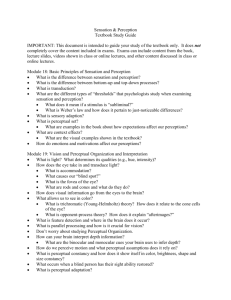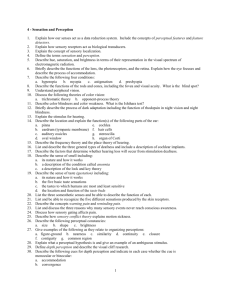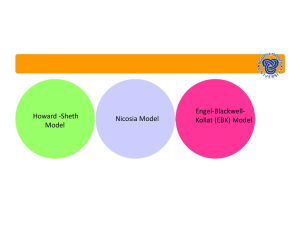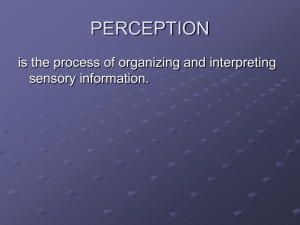object and objectivity
advertisement
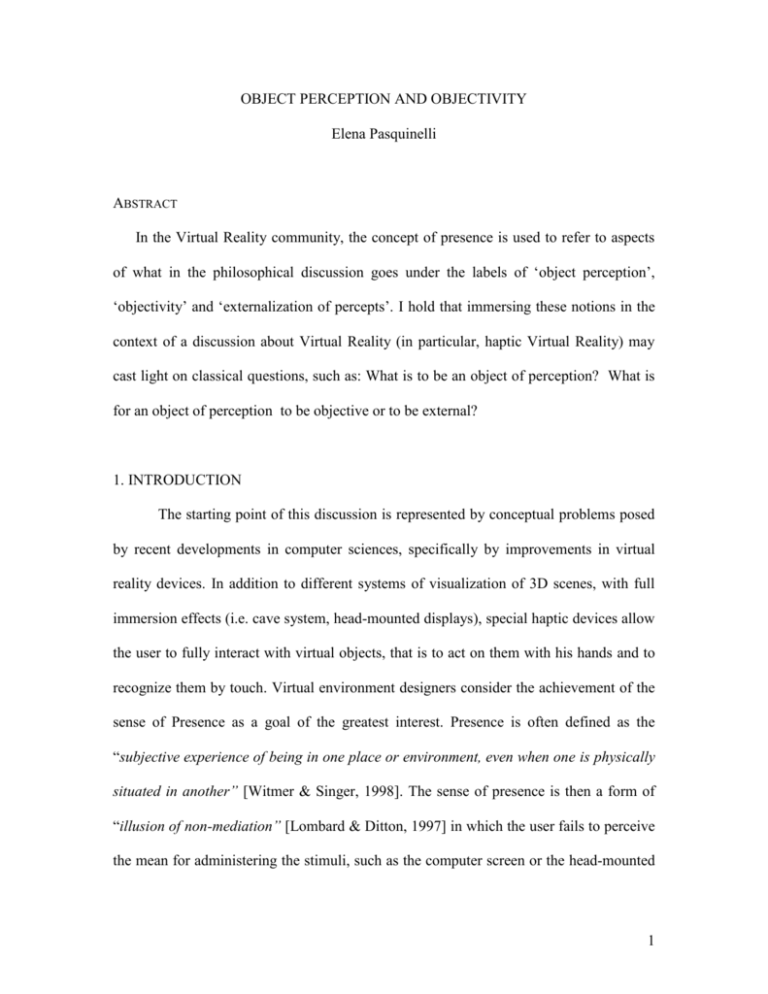
OBJECT PERCEPTION AND OBJECTIVITY Elena Pasquinelli ABSTRACT In the Virtual Reality community, the concept of presence is used to refer to aspects of what in the philosophical discussion goes under the labels of ‘object perception’, ‘objectivity’ and ‘externalization of percepts’. I hold that immersing these notions in the context of a discussion about Virtual Reality (in particular, haptic Virtual Reality) may cast light on classical questions, such as: What is to be an object of perception? What is for an object of perception to be objective or to be external? 1. INTRODUCTION The starting point of this discussion is represented by conceptual problems posed by recent developments in computer sciences, specifically by improvements in virtual reality devices. In addition to different systems of visualization of 3D scenes, with full immersion effects (i.e. cave system, head-mounted displays), special haptic devices allow the user to fully interact with virtual objects, that is to act on them with his hands and to recognize them by touch. Virtual environment designers consider the achievement of the sense of Presence as a goal of the greatest interest. Presence is often defined as the “subjective experience of being in one place or environment, even when one is physically situated in another” [Witmer & Singer, 1998]. The sense of presence is then a form of “illusion of non-mediation” [Lombard & Ditton, 1997] in which the user fails to perceive the mean for administering the stimuli, such as the computer screen or the head-mounted 1 display, and directs his attention to the artificial environment. Between the factors that are considered as responsible of this perceptual phenomenon different authors cite the realism of the virtual scene, the naturalness of the situation, the richness of the peripheral stimulation; and also the provision of multisensory experiences, the active involvement of the participant and the symbolic and cultural meaning of the virtual environment. It is difficult, anyway, to find a definition of the kind of presence virtual reality make possible. It is useful to identify first the differential character of the experience with virtual reality systems. Let us imagine to read a book, and to be so immersed in the adventures of the hero that we feel to be transported in his world; our imagination (or something like that) is working, but not our senses or muscles: reading is a symbolic experience, not a motor and perceptual activity. If we now move to symbolic experiences that have also a perceptual aspect, such as the fruition of cinema or photography, we should observe that the interactive element is still lacking: one cannot operate with the objects included in a movie. On the contrary, a virtual object is something one can have the impression of touching, seeing, listening and actively modifying. The problem of presence then regards the perception and action within a world (even if synthetic) with its objects and events. Another step in the clarification of the notion of presence can be made by focusing on the objects and events of the virtual world that is created, instead of investigating the feelings and impressions of the user (the sense of presence). In this way the problem of presence is conceived as the problem of producing virtual objects and events that are credible to the users: the user is not translated in another world, but cheated. It is a question of credibility or believability. 2 How are believable objects made? It’s trivial that real objects of the real world are credible. Then, virtual worlds’ designers do not have but to faithfully reproduce the objects of the real world! Virtual reality devices and computer sciences have impressively developed but not as much as to exactly reproduce the physical characteristics of real objects; possibly they will never do that. It is then necessary to turn from the attributes of the objects of the external world to the characteristics of the perception of such objects that are credible to all of us. I plan to analyze some of the processes that are involved in the construction of complex, multisensory percepts. First, there is the problem of the perception of objects as opposed to the perception of simple features (binding problem). There is no consensual view as to how to answer to this question, and I will concentrate on the active role of perceptual mechanisms in shaping perceptual units through the example of the construction of multisensory perceptual units and of the role of expectancies (section 2). I will then refer to philosophical discussions and experimental inquiries about objectivity (section 3). 2. PERCEPTUAL OBJECTS Perceiving an object, say a rose, is different than perceiving features, even a cluster of features. The well-known man who mistook his wife for a hat [Sacks, 1998], for instance, is an example of the capacity of describing a red form with a green appendix about 15 centimeters long, without recognizing the rose. Normal people that do not suffer of visual agnosia (see [Farah, 1990]) can make a similar experience when, searching in a 3 bag, they found something they do not immediately recognize by touch: it is a cylinder and about five centimeters long and plastic stuff and it can be opened… it is just when they pull it out from the bag that they recognize an ordinary lip-stick. How then object are recognized? [Spelke,1990] argues that children first form a representation of the superficial appearance of the visual stimulus and only then parse the perceived structure in objects that are connected and persistent units; the fundamental mechanisms that operate on visual stimuli in order to parse it into units corresponding to objects are sensitive to cohesion, connection, rigidity and no action at distance. The so-formed units are then recognized as specific, familiar objects. Even if it is not recognized, the lipstick can still be perceived as an object: one doesn’t know exactly which object it is, but it is something that has been successfully individuated within the stimulus, that is separated and identified as a connected unit. In Spelke’s view the perception of objects resembles to the game of cutting figures from a magazine page which is rich of colors and shapes. Between the mechanisms implied in the perception of objects that are not recognized, [Kahneman & Treisman, 1984] suggests the existence of temporary object files. Attention can be directed on temporary object files that contain information regarding features such as color, shape, localization, etc. Objects can then be perceived and visually tracked even if they are not identified as objects for a specific type. [Pylyshyn, 2001] argues for the existence of a mechanism (visual indexing) that can index one or more proto-objects: the index draws the attention on something object-like (extended in space, with boundaries) that is in a certain position of the visual field, even without taking into account other characteristics such as color or shape. The object is then conceived as a sort 4 of candy floss: the pseudo-object is the stick around which the different features condense. (For a review of the problem of objects and attention, see [Scholl, 2001]). Without committing with these positions, it is arguable that an object is something more and something less than a pattern of stimulation, even than a rich pattern of stimulation. It is something less, because something like a “complete” pattern of stimulation doesn’t seem necessary in order to make the perceptual experience of an object. A cat behind a fence is still perceived as a cat, and not as: a slice of cat, a stick of wood, a slice of cat, a piece of wood, ... In fact, even if we don not really see all the cat, we still make the visual experience of a cat. Change blindness phenomena show that we can miss important parts of the scene, and that we normally do it. By the use of special techniques (such as "flicker" or "mudsplashes"), or by making the change simultaneous with an eye saccade, the visual transient can be swamped by other transients, and attention can be diverted from the change location. The results show that in these circumstances, very large changes can be missed [O’Regan, 2000]. The visual system doesn’t seem to work as a system for representing all the elements of a visual scene. If now we turn to classic experiments made by [Johannson, 1973] on the perception of human movement we can also see why perception is something more than a pattern of stimulation. In fact, very poor patterns of stimulation can be perceived as complex events, provided they confirm to certain patterns. By filming walkers and runners in a dark room with lights attached to their main joints, Johansson demonstrated that such simple moving light spots were perceived as human movements. By some examples from intersensory conflicts and the reactions of the perceptual system to incongruity I will suggest that, when faced to multiple stimuli, the perceptual 5 system operates as if it had different solutions at disposal, and that a coherent percept is often preferred. 2.1 A binding problem Understanding how several properties from different sensory modalities are bound in order to form the percept of a multimodal object is one of the aspects of the research on the so-called “binding problem” (see [Roskies, 1999] for a review of the problem). [Treisman, 1996] describes the case of erroneous associations of features (illusory conjunctions) and then presents the correct binding of properties as a problem for the perceptual system. Between the solutions suggested for the binding problem neurophysiology has identified mechanisms related to the temporal synchrony of the perceived features [Crick & Koch, 1990], the existence of neurons that receive information from multiple sensory modalities and the presence of parallel processing of stimuli from different sensory modalities at the level of the superior colliculus [Stein & Meredith, 1993]. Other approaches to the problem of multisensory perception deny the necessity of such mechanisms in order to explain the experience of a multisensory percept. Accordingly to sensorimotor approaches to perception, the unity of the experience is granted by the common motor activities that are connected with the multisensory perception of the objects [O’Regan & Noe, 2001]. [Stoffregen & Bardy, 2001] suggests the existence of a global array that includes different environmental properties that are directly perceived as combined. 6 It is not a simple matter, since in normal perception the properties coalesce in such a way that it is difficult to disentangle them or to observe them combining. But there exist perceptual experiences where the disentanglement is constitutive. It is the case of the experiments on perceptual conflicts (e.g. of intersensory conflicts), where two or more discrepant experiences are proposed to the subjects. In fact, we can define a perceptual conflict as the presence of two contradictory elements (for instance small an big) in one and the same perceptual unit (an object which appears at the same time small and big), so that an incoherent perceptual grouping is produced. The creation of an incoherent percept doesn’t seem to be a necessary outcome for the perceptual system when presented with discrepant stimuli. The reactions of the perceptual system faced with discrepant stimuli will then give us an insight in the mechanisms that normally operate in the construction of complex perceptual units, that is in the binding of the multisensory properties of a percept. Let us imagine that the perceptual system is presented with visual and tactile information regarding the dimension of an object, and that the visual and tactile stimuli are suitably modified by the experimenter so to obtain a visual percept which is a half of the extension judged by touch. This is a classical study presented in [Rock & Victor, 1964] and reconstructed by [Heller, Calcaterra, Green & Brown, 1999]. The subjects are at the same time touching a square object and looking at it through the interposition of minifying lenses that reduce its visual dimensions (the subjects are unaware of this modification, so they assume they look at and touch one and the same object). We know that the perceptual system appreciates the difference of the two partial percepts, since the 7 judgments given in the purely visual and in the purely tactile situations are different. How will the perceptual system react? [See Tab. 1] The perceptual system could consider the two discrepant stimuli cannot regard one and the same unit, and decide that there are two objects, one which is seen and one other which is touched. In this case there is no conflict: the partial percepts are distributed in different units. This is what happens normally when we look at a cake on the table while tasting and feeling the pizza we are eating: there are no reasons to combine the visual with the tactile percepts! But we have seen that in the cited experiment the subjects have some reasons to put the partial percepts together: percepts seem to have the same spatial location and the experimenter explicitly affirms they come from one and the same object. Within a certain range of discrepancy and in reason of certain assumptions of unity, the perceptual system could then combine the partial percepts in one single unit. There are then two possibilities. Remember that the perceptual system is able to correctly assess the discrepancy between the percepts. First possibility. The two partial percepts are suitably modified in order to enter the final unit without giving rise to an explicit conflict. The conflict is then solved. [Rock & Victor 1964] had established that the final percept was dominated by the visual appearance. In other terms, the multisensory percept corresponds to the visual one; the tactile percept is ignored. It is what happens for example in other well-known illusions such as the ventriloquist effect, where the voice of the puppet master is perceived as coming from the puppet’s mouth: vision seems to totally bias audition. Accordingly to [Heller, Calcaterra, Green & Brown, 1999] the perceptual system seems to be able to find other solutions than to simply ignore one of the two discrepant modalities. The solution 8 the perceptual system finds appears to depend on the context of the experiment. When the judgment requested to the subjects is framed in term of a precise measure (by indicating a visual measure on a ruler or by showing the measure by shaping a pinch with the fingers), there is dominance of a sensory modality over the other. In the case of the ruler vision dominates, but in the case of the pinch touch dominates over vision. On the other hand, when the subjects are asked to match the perceived extension with one object from a group of haptic or visual standards, the judgments seem to take into account both vision and touch in an equal manner (with no difference between the visual matching and the haptic matching). Similar results have been obtained in other situations: for instance, (discrepant) visual and tactile stimuli seem to equally participate in the perception of a textured surface [Lederman, Thorne & Jones, 1986]. In the case of the micro-structure of an object as well, the relative bias depends on the context of the perceptual task. In fact vision seems to (relatively) dominate over touch when the subjects are asked for a spatial judgment (in terms of the spatial density of the micro-elements of the surface). The dominance is only relative, since the tactile information is not ignored, but simply participates in a secondary manner to the aspect of the final percept (visual bias over touch is 73,6 %). When the subject arte asked to evaluate the roughness of the same surfaces the visual bias seem to diminish to 33% and touch dominates 73,2% over vision. Second possibility. The two partial percepts are not modified. The final percept then explicitly contains two discrepant elements and the subject experiences a perceptual conflict. The object feels bigger than it looks. It doesn’t seem to happen in this particular case, but it is an interesting possibility since the perceptual system can immediately detect the presence of an explicit conflict. 9 Tab. 1 – Cases of conflict 2 units Separation of the elements: No conflict non-ambiguous percepts 1 unit Discrepant elements as they Explicit conflict are: ambiguous percept Discrepant elements Solved conflict: modified: non ambiguous - perceptual result percepts. with dominance of Two mechanisms: one of the elements - dominance - compromise - perceptual result with compromise 2.2 The search for coherence We have seen that the perceptual system uses to react in different manners to discrepancies: discrepancies can be perceived as such, can be avoided by separating the discrepant stimuli or can be solved by endorsing a compromise between discrepant stimuli or even by giving rise to a case of dominance. Seeking for coherence seems anyway to be a common trend in perception. It seems plausible to interpret the modifications of the discrepant elements run into when combined in a final non-conflictual percept as an attempt to maintain the coherence of the perceptual experience in spite of some contradictions. The perceptual system can be construed as adopting these mechanisms in order to reestablish the 10 conditions of perception, which is normally coherent. This “propensity” for coherence is related to the structural relations of action and perception. In fact, if we consider perception as a guide for action, we can understand the difficulty a motor-perceptual system encounters in acting adequately when experiencing a perceptual conflict. Let us imagine to ride a vehicle in a room and to wear a head mounted display through which we visualize the movement we are effectuating. At a certain moment the display for the visualization begins to show us a different pattern of movement which is not coherent with what we feel we are doing. We would probably stop, inhibited, because we would be in a difficult situation: where to go when vision and proprioception are in disagreement? How to program future actions in a world that is experienced as incoherent? Perceptual conflicts seem then to have a negative value for programming actions, since they paralyze our decisions and diminish our capacity to behave in the world. How much do the muscles of the fingers extend or flex to grasp an object that is little (for vision) and big (for touch)? When perception is a guide for action, the experience of a perceptual conflict has a disrupting effect in the starting of the action. The behavioral result of a perceptual conflict is not simply an error in action and perception relatively to the external reality (an illusion): is a paralysis of action. Perceptual conflicts seem then to have a negative value in the interaction with the world, since they inhibit our decisions and diminish our capacity to act. The search for coherence may conduct the perceptual system to give rise to percepts that are internally coherent but do not correspond to the objective, external reality, since reality presents discrepancies. When it is the case, the perceptual system 11 can be said to give more importance to coherence than to truth, if truth is conceived as adequacy to the external reality (to the bare stimuli). 2.3 The role of expectancies in the perception of objects We should now turn to another aspect of the different solutions that the perceptual system adopts when faced to incongruity. What makes the perceptual system “choose” to separate the discrepant percepts or to include them in a unit? What makes it adopt dominance or compromise? Are there conditions other than those regarding the stimuli in cause (i.e. the degree of discrepancy) that are relevant for the construction of the final percept? [Welch & Warren, 1981] cites many different conditions that are susceptible to have an influence on the perceptual outcome, in addition to the stimulus variables: the characteristics of the modalities involved, the allocation of attention and historical factors. Past experience with the event being perceived and general experience with modalities involved, can in fact affect the observers’ assumption of unity (if the stimuli are to be considered as coming from one and the same source or from two distinguished objects) and thus the perceptual outcome; the result of a strong assumption of unity is a perceptual outcome consonant with a single physical event. The assumption of unity can be influenced by the experimenter instructions, and other cognitive hypotheses and considerations. It is possible to re-formulate this condition in terms of expectancies. As stated in [Bruner & Postman, 1949] “It is a truism worth repeating that the perceptual effect of a stimulus is necessarily dependent upon the set or expectancy of the organism” (p. 206). In the cited article the authors defend the hypothesis that, “given a stimulus input of certain characteristics, directive processes in the organism operate to organize 12 the perceptual field in such a way as to maximize percepts relevant to current needs and expectations and to minimize percepts inimical to such needs and expectations”. (ibidem, p. 207). Confirmation of expectations has a central role in this view, since when wellestablished expectancies fail of confirmation the organism may envision perceptual reorganization. The violations of perceptual expectancies (“an unexpected concatenation of events, a conspicuous mismatching, an unlikely pairing of cause and effect”, ibidem, p. 208) or incongruities pose a problem to the organism. In Bruner and Postman’s view the organism can perceive the incongruity (be aware of the contradiction), but, as long as possible, “the organism will ward off the perception of the unexpected” (ibidem, p. 208). This is shown by an experiment Bruner and Postman have done by rapidly exposing subjects to normal (five of hearths, ace of hearts, five of spades, seven of spades) and trick playing cards (i.e. black three of hearts or red two of spades). The results indicate that the recognition threshold for the incongruous playing cards is significantly higher than the one for normal cards; four reactions to incongruity are described. Dominance and compromise reactions are characterized by a perceptual denial of the incongruous elements in the stimulus pattern; in the first case the form or the color dominates and the subject perceives a normal card, i.e. a normal, red three of hearts instead of a black one, or a black three of spades. The perceptual result then meets the expectancies about normal playing cards. In the second case a compromise object is perceived which composes the conflict, i.e. a grayish three of hearts. The perception of incongruity can also produce disruption, in that the subject cannot solve his task of recognition. This failure in perceptual recognition is analogous to the inhibition of action provoked by perceptual conflicts, since it diminishes the efficiency of the organism. It seems not to be 13 frequent. Finally the incongruity can be recognized. It is interesting to notice that the recognition of the incongruity is accompanied by a sense of wrongness: the subject suddenly or gradually begins to feel that there is something wrong with the stimulus; this sensation can turn to disruption or give rise to recognition of the incongruity. The subjects of the experiment then manifest a resistance to incongruity between the actual stimulus and their own expectations. As in the case of perceptual conflicts, the perceptual system tends to avoid the violation of coherence (here a diachronic form of coherence between the expectancies produced by past experiences and actual perception). When the incongruity is not suitably modified the subject has the sensation that something is going wrong since he is faced with an ambiguity that he can accept (recognition) or not (disruption). In the case of disruption the violation of the (diachronic) coherence reveals to be paralyzing: ambiguity is a hard condition to be managed by action and perception. 3. CREDIBLE OBJECTS A special device [Bach-y-Rita, 1982] has been conceived to convey visual stimuli to blind people. The device is called TVSS or Touch Vision Sensory Substitution system and is composed of a video camera, a transducer and a vibrotactile stimulator which can be placed on different parts of the body of the user; the light stimuli are transduced into tactile patterns and the user is asked to recognize the object that is viewed by the camera. Experiments with blind and blindfolded people indicate that two different outcomes are possible depending on the active or passive use of the camera. When the camera is fixed and the user cannot move it in order to actively explore the environment the tactile pattern is perceived as a simple stimulation of the skin (a sensation) and recognition is 14 impaired. On the contrary, when the user has the possibility of directing the camera as he would do with his eyes he perceives an object there, in the external world, and not a local stimulation; then recognition is possible. Active exploration seems then to make the difference between a distal object and a proximal stimulation (a sensation) when the pattern of stimulation stays unmodified. 3.1 The problem of objectivity The projection of the experience in the external world (external to the perceiver’s mind-body), the distinction between distal and proximal experience in the sense of the Bach-y-Rita experiment, is related to the problem of objectivity. In fact, [J. Proust, 1999] suggests 1 to redefine the traditional definition of objectivity1 in terms of Traditionally, objectivity is associated with independence relatively to the mental activity, so with a distinction between internal and external. What is only in the mind is subjective, it is objective what is outside or independent from the mind. [Strawson, 1959], for instance, equates objectivity with unperceived existence. Objectivity is the property that allows the justified distinction between the experience of the subject and the object of the experience. An event that exists even when it is not experienced by a perceiver can be re-identified after an interruption in the experience. In Strawson’s opinion, re-identification (the possibility of re-identifying the object as the same object that has been perceived before the interruption of the perceptual experience) is then a relevant criterion for this definition of objectivity. Strawson’s definition of objectivity includes the reference to spatial concepts in that only a spatially organized experience allows re-identification. 15 distality/proximality: an animal possesses an objective world when it is able of making reference not only to the proximal sensations provoked by a stimulus but even to the stimulus as distal. An experience which is projected in the exterior is not necessarily true of the external world: systematic illusions are perceptual experiences that are projected distally and not experiences of proximal stimulations. Illusions can be defined as perceptual errors, in that they violate some form of truth; classic optic illusions (as the Mueller-Lyer illusion) in particular can be described as violations of the adequacy of the perceived object to the real object. To avoid the comparison of the perceived reality with reality as it is unperceived, we can say that the Mueller-Lyer illusion is characterised by a discrepancy between the reality as it is perceived with the bare senses and the reality that is measured with a ruler. “It is extraordinarily hard to give a satisfactory definition of an “illusion”. It may be the departure from reality, or from truth; but how are these to be defined? As science’s accounts of reality ever more different from appearances, to say that this separation is “illusion” would have the absurd consequence of implying that almost all perceptions are illusory. It seems better to limit “illusion” to systematic visual and other sensed discrepancies from simple measurements with rulers, photometers, clocks and so on.” [Gregory, 1997, p. 1122] Even if they consist in perceptual errors, as they violate the adequacy to reality, illusions are often perfectly credible; in fact, we are rarely aware of being victims of an illusion. Objectivity and truth can then be in some way disentangled, when truth is conceived as adequacy to the external (or measured) reality. In this sense it is possible to produce 16 illusions of virtual objects that can be considered objective even if they do not really exist in the external world. 3.2 Objectivity and expectancy If it is conceivable to create virtual worlds that are not “bare” copies of the physical world and that are credible, objective worlds, what are then the relevant characteristics that make virtual worlds be objective? Following R. Carnap (Carnap, 1928) there are two possible definitions of the term “objectivity”: objectivity can be assigned to a judgement which is constrained, nonarbitrary; or objectivity can be interpreted as intersubjectivity, that is as the independence from the subject’s judgement, validity for all subjects. All the objects of the world can be reduced to their perception by the subject, then to the mental activity of the subject; but, since the structure (even if not the content) of perception is common to all subjects, this subjective starting point of all knowledge gives rise to the constitution of objects that are intersubjectively valid, and then to an objective world. In the constitution of the world the perceptions (Erlebnisse) of the subject can be taken as they are, without asking if they are real or not: in Carnap’s approach to the constitution of an objective world there is no room for comparing perception to the unperceived reality, only the structural characteristics of the perceptual experience are relevant. [D. Davidson, 1982] proposes a nice test for objectivity. Someone puts his hand in his pocket and finds a coin. If he his surprised in finding the coin, then he comes to believe that his previous belief about his pockets and coins was false. In this way he becomes aware that there is an objective reality which is independent from (previous) 17 beliefs. In fact, it is not possible to be surprised without possessing some beliefs (in the holistic view of Davidson to possess a belief is to possess a set of interconnected beliefs); reciprocally, Davidson states, if one possesses some beliefs he is exposed to the possibility of being surprised. In fact, something can happen, that makes him change his mind. But for being surprised, the subject has also to be aware of the contrast between what he was used to believe and what he is coming to believe. The subject that can be surprised possesses the concept of belief (a belief concerning beliefs), then the concept of an objective truth that is independent from beliefs. Beliefs, such as those described by Davidson, are intrinsically linguistic, and Davidson’s concept of objectivity is strictly dependent on language too. Beliefs are in fact identified through a process of more or less radical interpretation that involves a speaker and a charitable interpreter (in the sense that he is disposed to accord to the speaker all the rationality and coherence that make what he says to belief true for the interpreter). “Surprise is a wonderful dependent variable, and should be used more often in experiments; it is easy to measure and is a telling betrayal of the subject’s having expected something else.” [Dennett, 2001] In general, surprise can be considered as the outcome of an unattended expectation, of the non-fulfillment of an expectation. The subjects of [Bruner & Postman, 1949] experiment react with surprise when faced to unexpected stimuli, when they are not able to assimilate the actual stimulus to past beliefs about play cards. [Dennett, 2001] states that “Surprise is only possible when it upsets belief. But there are examples of nonlinguistic expectancies.” A typical example is the pre-shaping of the hand when approaching an object for reaching; in general all the adjustments of the body that 18 anticipate and prepare the action with specific objects are based on the expectations about the aspect and behavior of the object itself. It is then possible to consider a wider set of behaviors as relevant to the question of objectivity, including motor preparation and other non-linguistic forms of expectancy. If a (virtual) world is to be considered objective, it should be suitably constructed in order to produce, at least, different kinds of expectancies in the subject of the interaction. These expectancies can be measured in term of the reactions of surprise that are produced by changing some aspects of the objects of the interaction and in term of the modifications that the body of the subject encounters in order to adapt to the objects he is going to approach. 3.3 Objectivity and coherence The phenomena related to surprise and motor anticipation or preparation are indicative of the presence of expectancies that the subject is not necessarily able to express linguistically. Another type of behavior that is related to the possibility of constructing plans for action is the attitude to correct the perceptual experience in order to construct coherent representations of the world. As stated before, in fact, the coherence of the perceived world/object is a fundamental factor in the possibility of planning an efficient action. For instance, [Stein & Meredith, 1993] describe the existence of specific neural mechanisms that are dedicated to align the neural visual and auditory maps that are present in the superior colliculus, as in the case of the orienting behaviour of the cat that turns the head in the direction of an auditory stimulus. [J. Proust, 1999] assigns the possess of an objective world to the organisms that share the capacity of correcting their 19 experience in order to achieve veridicality. In other words, an organism possesses an objective world if it is structurally capable of correcting its own states when faced to contrasting evidence. “The very idea of a contrast between an inner representing state and an external, represented condition ... requires as its precondition that the animal be able to semantically evaluate its own representational states, in other words that it should be able to correct them adequately when faced with contrary evidence. Speaking of a semantical evaluation should not suggest that the animal is able, so to speak to exercise a logical competence and, inter alia, apply the concept of truth. It is only meant to suggest that a representational skill involves aiming at veridicality, and using when necessary corrective procedures to achieve veridicality.” [J. Proust, 1999] This structural capacity seems to Proust to be related to the presence of multiple sensory modalities. In fact, animals with different sensory modalities seem to possess specific mechanisms dedicated to the calibration-recalibration of the inputs: the inputs of one sensory modality are corrected when they are not spatially coherent with the stimuli of another sensory modality. This mechanism allows the animal to correct its sensory inputs in order to put them in one single spatially coherent perceptual frame.” [ibidem, p.] Even if human beings possess mechanisms for correcting their inputs and achieve a certain degree of perceptual coherence, it is important to provide proper stimuli that are suitable to be organized in a coherent fashion by human beings with their capacities. Let us imagine a subject exposed to a virtual environment where objects change continuously and never reacts in the same way to the user’s actions. The user will not be able to form expectancies about the objects of this world, not to be surprised or confirmed when some changing will happen. If asked to approach one object he presumably will not be able to form a specific motor project for reaching the object, and possibly he will feel paralyzed 20 or at least hesitate to start his action. The virtual environment provides stimulations that the subject cannot use as he does with stimulations from the real world. Objective (virtual) worlds are then to be constructed in the respect of coherence and in reason of the perceptual mechanisms that are involved in multisensory interactions. 4. CONCLUSIONS I envisaged the practical problem of constructing credible virtual objects and worlds as a problem of object perception and objectivity; then, I presented some mechanisms that are relevant for the construction of perceived objects and some factors that are relevant in order to consider them as part of an objective, even if not real or physical, world. The coherence of the perceptual outcome and the formation of expectancies have emerged as two relevant criteria for both questions. Specific mechanisms seem in fact to intervene in the construction of the perceived objects that tend to maintain coherence even when the incoming stimuli are discrepant. In the mean time, the coherence of perception is an important factor for different organisms in order to properly interact with an objective world. Expectancies, on their side, inform object perception and influence the perceptual outcome, but are also a resultant of the interaction of an objective world. In practical terms, two minimal requests for credible virtual worlds are the capability of producing expectancies and coherent percepts in the users. REFERENCES 21 Bach-y-Rita, P. (1982). Sensory substitution in rehabilitation. In M. S. L. Illis, & H. Granville (Ed.), Rehabilitation of the Neurological Patient (pp. 361-383). Oxford, UK: Blackwell Scientific. Bruner, J., Postman, L. (1949). On the perception of incongruity: A paradigm. Journal of Personality, 18, 206-223. Carnap, R. (1967). The logical structure of the world. Berkeley: University of California Press. Crick, F., Koch, C. (1990). Towards a neurobiological theory of consciousness. Seminars in the neurosciences, 2, 263-275. Davidson, D. (1982). Rational animals. Dialectica, 36, 318-327. Dennett, D. C. (2001). Surprise, surprise. Comment on O’Regan and Noëcomment on O’Regan and Noë for BBS. Available: http://ase.tufts.edu/cogstud/papers/noeoregan.htm. Farah, M. J. (1990). Visual agnosia. Cambridge, Mass.: The MIT Press. Gregory, R. L. (1997). Knowledge in perception and illusion. Philosophical Transactions of the Royal Society of London, B 352, 1121-1128. Heller, M. A., Calcaterra, J. A., Green, S. L., Brown, L. (1999). Intersensory conflict between vision and touch: the response modality dominates when precise, attention-riveting jugements are required. Perception & psychophysics, 61(7), 1384-1398. Ijsselsteijn, W., Riva, G. (2003). Being there: the experience of presence in mediated environments. In F. D. G. Riva, W. A. Ijsselsteijn (Ed.), Being there, effects and measurement of user presence in synthetic environments. Amsterdam: IOS Press. Johansson, G. (1973). Visual perception of biologic motion and a model for its analysis. Perception & Psychophysics, 14, 201-211. Kahneman, D., Treisman, A. (1984). Changing views of attention and automaticity. In R. P. R. Davies (Ed.), Varieties of Attention (pp. 29- 61). New York: Academic Press. Lederman, S., Thorne, G., Jones, B. (1986). Perception of texture by vision and touch: multidimensionality and intersensory integration. Journal of experimental psychology: human perception & performance, 12( 2), 169-180. Lombard, M., Ditton, T. (1997). At the hearth of it all : the concept of Presence. Journal of computer-mediated communication. O'Regan, K., Noe, A. (2001). A sensorimotor account of vision and visual consciousness. Behavioural and brain sciences, 24(5). O'Regan, K., Noë, A. (), , , , , 2000. (2000, June 29-July 2, 2000). Experience is not something we feel but something we do: a principled way of explaining sensory phenomenology, with Change Blindness and other empirical consequences. Paper presented at the ASSC Conference: THE UNITY OF CONSCIOUSNESS: BINDING, INTEGRATION, AND DISSOCIATION, Brussels. Proust, J. (1999). Mind, space and objectivity in non-human animals. Erkenntnis, 51(1), 41-58. Pylyshyn, Z. W. (2001). Visual indexes, preconceptual objects, and situated vision. Cognition, 80, 1-46. Rock, I., Victor, J. (1964). Vision and touch; an experimentally created conflict between the senses. Science, 143, 594-596. 22 Roskies, A. L. (1999). The binding problem. Neuron, 24, 7-9. Sacks, O. (1998). The Man Who Mistook His Wife for a Hat and Other Clinical Tales. NY: Simon & Schuster. Scholl, B. J. (2001). Objects and attention: the state of the art. Cognition, 80, 1-46. Spelke, E. S. (1990). Principles of Object perception. Cognitive science, 14, 29-56. Stein, B. E., Meredith, M. E. (1993). The merging of the senses. Cambridge, Mass.: MIT Press. Stoffregen, T. A., Bardy, B. G. (2001). On specification and the senses. Behavioural and brain sciences, 24, 195-261. Strawson, P. F. (1959). Individuals. An essay in descriptive metaphysics. London: Methuen. Treisman, A. (1996). The binding problem. Current opinion in neurobiology, 6, 171-178. Welch, R. B., Warren, D. H. (1981). Immediate perceptual response to intersensory discordance. Psychological bulletin, 88, 638-667. Witmer, B. G., Singer, M. J. (1998). Measuring Presence in Virtual Environments: a Presence Questionnaire. Presence, 7(3), 225-240. 23


